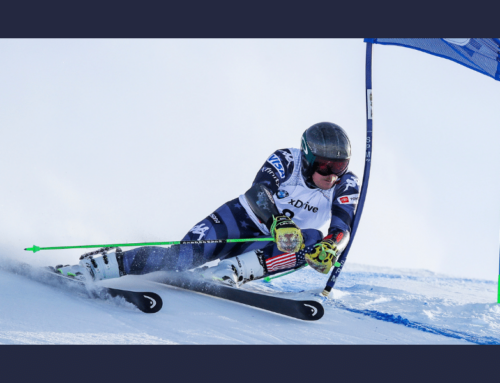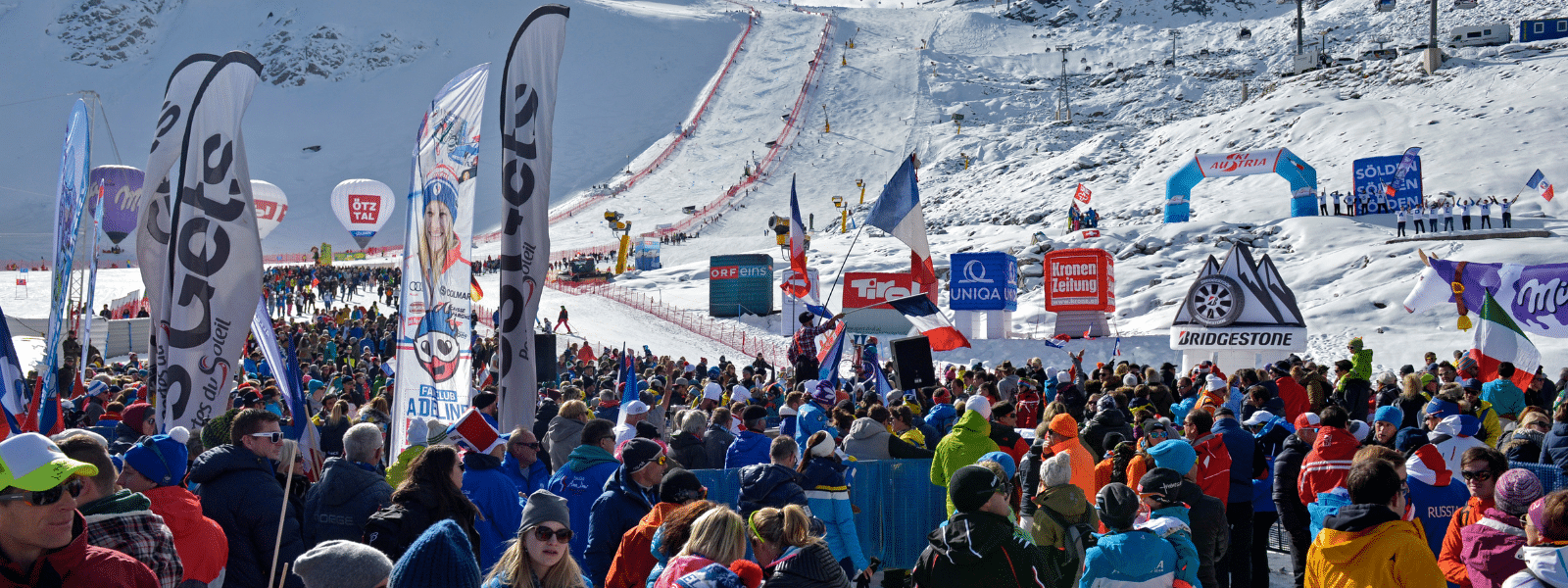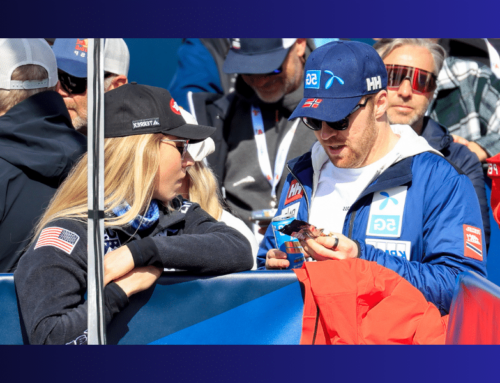Austria Hungry for More, but Star Coach Quits
Remember the days when Austria dominated everything in alpine skiing? It was “Austria against the rest.” Not anymore. Top-10 dominance is rare, and victories are further apart. What needs to change? Should coaches stay or go? Discussions are intense. Today, one day before the Kronplatz women’s World Cup GS races, star coach Livio Magoni resigned from his job as Katharina Liensberger’s personal coach on the Austrian technical team.
ÖSV Alpine Director Herbert Mandl updates Ski Racing’s readers on which ingredients are missing and pinpoints essential training for young racers. Ski Racing also dips into some of the ongoing discussions, opinions and the latest developments.
Haven’t served it up
The Austrian Ski Federation (ÖSV) is known for its massive budget, great resources, and colossal teams of athletes, coaches and support staff. The outcome? As of now, not equally impressive. Granted, there are still victories, podiums and top-10 results, but not like in the past, and not as remarkable as you’d expect with their excellent resources.
The women’s technical team has had the most challenging start of the 2022/23 season, which hasn’t gone unnoticed by the Austrian media. The pressure to perform is high, both internally and externally, and you can detect the discouragement and almost disbelief on the faces of some of the tech racers after they cross the finish line and see their race time.
The next women’s World Cup races in the technical events are the two giant slalom races in Kronplatz, Italy on January 24-25. Giant slalom has been especially disappointing so far. The last time an Austrian woman achieved a podium in a World Cup giant slalom race was in 2019. (Liensberger in Lienz, Austria). This January, Liensberger and other expected top teammates hit a low point when they didn’t qualify for the second run in World Cup giant slalom.
Austria is hungry for more. Alpine skiing is engrained in the country’s culture, traditions and economy. As the season moves on, discussions have intensified. What should and will the mighty ski federation do to improve the short- and long-term results?
New chefs, new menus
Significant changes were made within the ÖSV during the past year and a half. In October 2021, right before the opening Sölden World Cup races, a new management group took over the leadership of the Austrian Ski Federation. It was a considerable leadership change following long-time president Peter Schröcksnadel and a very brief period with Karl Schmidhofer as president. (Schmidhofer stepped down after a few months due to an unexpected family illness).
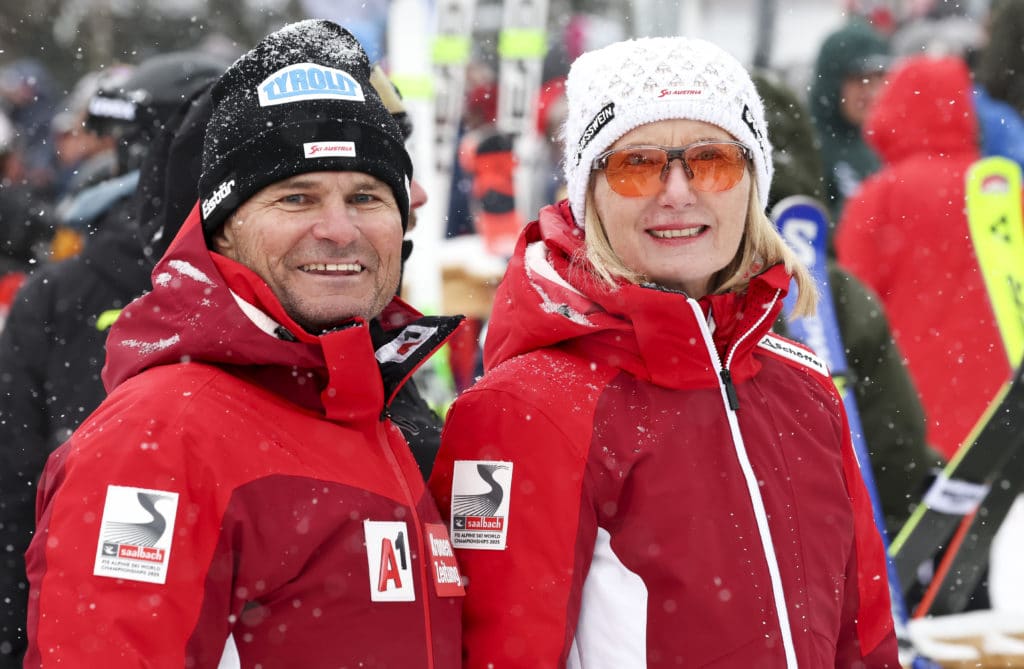
Towards the end of the 2022 Olympic season, the new management group consisting of President Roswitha Stadlober, Financial Officer Patrick Ortlieb and Secretary General Christian Scherer wanted significant shifts in the coaching staff. International coaching carousel: Big players on the move Herbert Mandl, with his many years of experience as an ÖSV coach, including head coach for both the women’s and men’s teams, was brought back, this time as the alpine director.
The Austrian Ski Federation recruited the coaches and staff it wanted, including Magoni as a personal coach for the 2021 slalom World Champion Liensberger. However, some key people also left. This included expert staff moving from the ÖSV to Marcel Hirscher’s new ski brand Van Deer. Talent Transfer to Hirscher’s Van Deer “Replacing such top people one-to-one is impossible. They don’t even exist in the free market,” Mandl commented, according to Kronen Zeitung, May 8, 2022. Replacements had to be found swiftly, as late as summer 2022, including a new ski technician for Liensberger.
What’s cooking?
“From the beginning, we have known we needed a change, especially for the technical teams, because even the results last year were not that good. That’s why we have replaced almost all the coaches on the tech side,” Mandl told Ski Racing in an early-January interview.
“We try to bring in a new atmosphere. Still, all the racers are the same because we do not have good enough young ones to fill the lack in the World Cup team. That’s why we try to get a better spirit into this team,” the alpine director explains, and continues talking about the women’s tech team: “So far, it didn’t work as we expected or hoped – that we can achieve better rankings or at least podiums in the World Cup. But I think we are not too far away. We see that in individual sector times, even second runs, we have had the best or good run times.
“Overall, I think the girls are expecting a lot from themselves. They are not able to ski relaxed in the races. Training is much better,” Mandl says, referring to his late-December talks with the Austrian women at the World Cup giant slalom and slalom races in Semmering, Austria.
He thinks the recipe is to continue training hard and to add one spice: Skiing with a higher risk. “They are not able to risk enough at the races because they are afraid to make mistakes, to be slow and so on. So, they are holding back quite a lot.” He points to Franziska Gritsch as a positive example of what is possible. She won the second run in slalom twice so far this season. Teammate Katharina Truppe placed third in the Killington World Cup slalom in November. The qualities needed for good results are there.
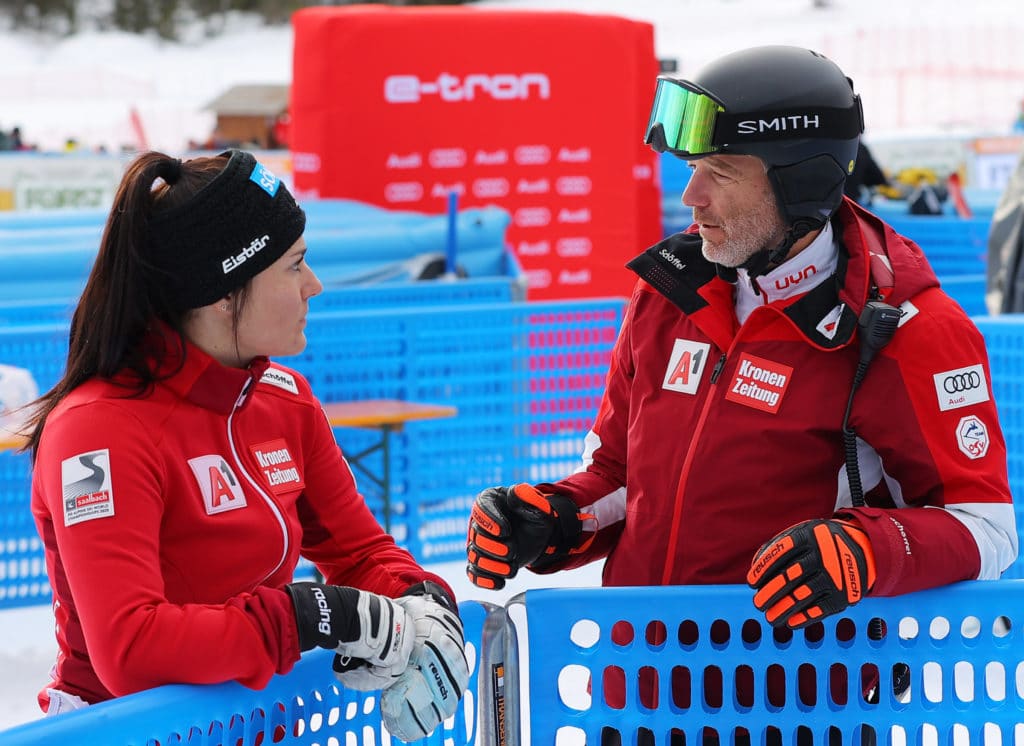
World Champion appetite
Another team member who has proved her talents is World Champion Liensberger. The 25-year-old holds five Olympic and World Championship medals and wishes for more success.
“She can do it in slalom; of course, she is already World Champion. She needs one successful race, and I think then it’s running again. She loads too much pressure on herself; it’s not even from the team. The expectations, of course, are there, but we try to give them time,” the alpine director says. He believes Liensberger must once again find the right tension level in her skiing. That will return her to successful racing. “She can be among the top three any time.”
Not the right combo
Liensberger’s best World Cup result so far this season is her fifth-place finish in the November Killington giant slalom. However, when the results dipped in December and early January, Liensberger became impatient. After failing to qualify for the second run in the January 8th World Cup giant slalom in Kranjska Gora, she called for change from the ÖSV. She said, “Now it’s important to take the right steps,” according to Austrian media.
Liensberger’s personal coach Magoni, who was hired in April 2022 by the ÖSV upon Liensberger’s wish, might not have liked the public critique. Magoni resigned today.
In a post on social media today, Liensberger writes: “Thank you, Livio. I am very sorry that we could not reach our goals together! I wish you all the best for your future!”
“There was a lot that didn’t harmonize, a lot that didn’t fit. Apparently not for Livio either, otherwise he wouldn’t have made the decision like that,” Liensberger said in an interview with the Austrian broadcaster ORF today.
“The resignation comes as a surprise to me, but it’s to be accepted. It’s a shame, because we still had a lot planned,” the women’s head coach Thomas Trinker said in an ÖSV news release, the Saltzburg24.at reported today. There have been different views on ski technique as well as communication difficulties. Liensberger and Italian Magoni communicated together in English, a foreign language for both, according to Saltzburg.24 and APA – Austria Presse Agentur.
“It was not planned that our common path would end prematurely due to technical, logistical, and organizational misunderstandings,” Magoni states, also according to Saltzburg.24 and APA.
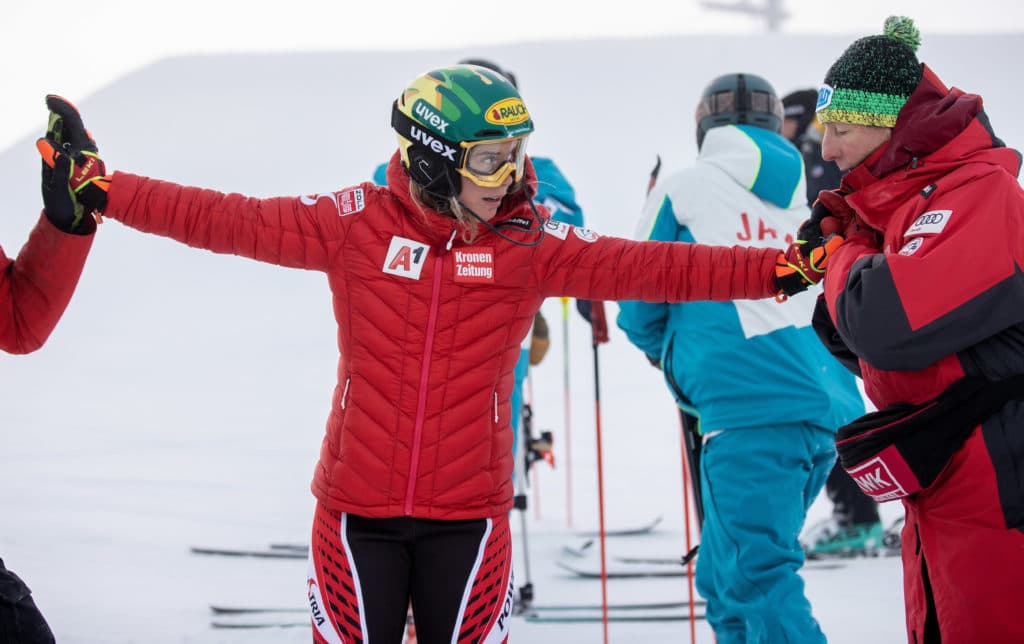
What’s in store for the next round?
Obviously, Magoni leaving creates a big change for Liensberger and the team and might affect their performance in World Cup giant slalom races on January 24-25. But what did the Austrian tech women bring to the table before this?
There were some highlights at the Flachau night slalom on January 10. Liensberger finished sixth. Truppe skied fast in the second run but struggled toward the end of the course, resulting in a non-competitive total time.
After her sixth-place finish, Liensberger felt slightly more positive: “At least sixth place is something in the right direction. It’s just not that easy at the moment and I think it’s good that a little stability can come in again, which I can now build on. Today, I really felt the turns in sections, where I then got the looseness and was able to let the ski go,” Liensberger stated, according to an ÖSV news release.
However, when asked a few days earlier whether there was an explanation for the current state of the women’s tech team, Liensberger pointed to the significant changes made in the coaching staff before the season. “You knew in the spring that everything had changed completely; the entire structure is new. Nobody is here from last year; it’s difficult to take experiences and value from the last season,” the slalom champion explained, according to ORF.at.

Slow cooking – patience makes perfect
Women’s head coach Trinker painted the following picture in an ORF broadcast after the Kranjska Gora World Cup: “It’s my responsibility that we ski fast and ski well. The basis is a good technique; we haven’t implemented that, but we have big plans. There are many things that we need to work through and that we need to do better. Our vision is that we want to be the best. We started doing that in the summer, but things need time to develop.”
Alpine Director Mandl shared similar thoughts with Ski Racing some days earlier: “I think we need more patience because new coaches have new ideas. They have new practicing skills that are brought into the training. But I am sure we have the best coaches we can obtain, even worldwide.”
Renowned Magoni, previously the coach of top racers Tina Maze and Petra Vlhová, was viewed as a great asset to Liensberger and the team. However, as it became clear earlier this winter that the cooperation didn’t seem fruitful, questions were raised about whether Liensberger and Magoni were the best match. Now we have the answer.
What about the coaching staff in general?
Time to stir the pot some more?
ÖSV President Stadlober stood by the side of the Austrian tech women in the Flachau night slalom finish area, as well as with the speed women at the two super-G World Cups in St. Anton, January 14-15. While in Flachau, she told the APA (Austria Press Agency) that she wants to leave the decision regarding coaches and possible changes to the team itself and that sports director Mandl and head coach Trinker make the decision as a team. “It’s about the women. It’s about the successful sport of our women – nothing is out of the question,” Stadlober stated.
The ÖSV president knows the pressure of World Cup and championship skiing. Once a top slalom racer for Austria in the 1980s, Stadlober (then Steiner) won a silver medal at the 1987 World Championships in Crans-Montana, Switzerland, placed fourth in the 1984 and 1988 Olympic slalom, and achieved 14 World Cup podiums, including eight World Cup slalom victories.
Women’s head coach Trinker did not rule out changing things around within the coaching staff at the time of the Flachau slalom. However, he did not want to throw somebody out or bring new people in during the race season, according to Austrian media.
Ortlieb is in charge of all financial issues at the Austrian Ski Federation and all sports issues regarding alpine skiing. He took a clear stance during an interview with VOL.at on January 9: “I’m not questioning the coaching staff. That’s out of the question.”
He pinpoints the World Championships, February 6-19, in Courchevel and Méribel, France as this season’s goal. “After that, we can have one or the other discussion,” Ortlieb says to VOL.at.
Cooks in the kitchen
Another discussion has come to light in the public sphere. Did the problems this winter start with the previous or current ÖSV management? Ortlieb hinted on ServusTV in late December that part of the current struggle for top results stems from how the ski federation managed things in the past.
According to Kleine Zeitung on January 11, former ÖSV president Schröcksnadel turns the blame back onto the current ÖSV management. “The new management has more or less replaced the entire management team. Four top talents have been let go, Toni Giger, Patrick Riml, Edi Unterberger, and Christian Mitter. And no company can cope with such a bloodletting without leaving a trace,” says Schröcksnadel. He also believes last summer’s loss of her previous favorite ski technician has had severe consequences for Liensberger.
Kleine Zeitung reports that Schröcksnadel suggests Ortlieb resigns from his positions in the ÖSV and stays in his hotel kitchen. In response, Ortlieb says Schröcksnadel is entitled to have his own opinion, according to ORF Vorarlberg the same day.
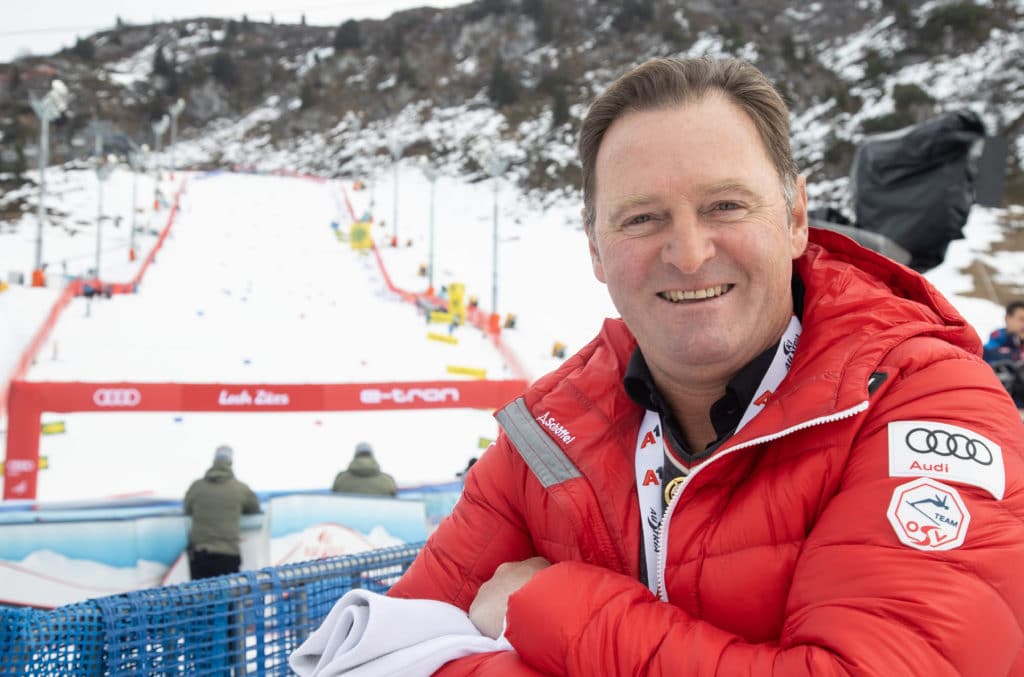
Dishing up victories
While the discussions spread in many directions in Austria, one person makes it hard for most potential top racers to win right now: Mikaela Shiffrin. The US racer almost seems unstoppable during her surge of World Cup victories.
“We don’t have athletes like Mikaela Shiffrin among our racers at the moment,” Mandl tells Ski Racing during our early-January talk. However, Austria did in the past. Mandl points to the previous generation with dominant, victorious skiers and mentions Marlies Schild (now Raich) and Nicole Hosp as examples. (Schild: 38 World Cup victories, 36 in slalom, four-time winner of the slalom globe, 2011 slalom World Champion and eight additional Olympic and World Championship medals. Hosp: 12 World Cup victories, winner of the overall globe and the giant slalom globe, 2007 giant slalom World Champion and eight additional Olympic and World Championship medals.)
What will it take for Austria to get back on top?
Hunger for success
Ortlieb shared his thoughts regarding the situation on ServusTV in late December:
“We must reduce the comfort zone, squad sizes and the number of coaches a little. The big entourage we travel with is almost embarrassing.
“As you can see, money doesn’t make you successful. We must make the athletes greedier, hungrier and snappier again and let them loose on each other a little more.”
A former Olympic and World Champion for the Austrian ski team, Ortlieb raced when Austrian team members faced brutal competition within the team to earn a starting spot in the championship and World Cup races.
Alpine Director Mandl says discussions regarding possible future team size changes must be kept within the ski federation and does not want to expand. Still, Mandl tells Ski Racing he understands where Ortlieb’s comments stem from:
“The times when he (Ortlieb) was on the team, we didn’t have as many coaches and helpers. He sees that we have almost doubled the number of helpers and coaches on the teams, but the success didn’t grow. That success doesn’t keep up at the moment with the support that we get from the federation.”
Continue to supersize?
Will the ÖSV reduce the Austrian squad, coaching, and supporting staff sizes before next season?
When talking to Ski Racing, Mandl says he doesn’t think so: “Of course, you need a certain amount (of coaches and support staff) to fulfill the individual requirements of the athletes.” Money is not an issue. “We are in a situation where our federation is very well situated financially, so we can fulfill everything we need.”
On the other hand, Ortlieb still maintains his previous idea of possibly streamlining the future ÖSV structure, according to the January 9 interview with VOL.at and ORF.at reports.
The young crop
Even though the women’s tech team has struggled for a few seasons, especially in giant slalom, the Austrian World Cup roster remains relatively unchanged. Mandl believes the federation has done all it could to give the racers the best possible on-snow training before this season. They have also increased the amount of ski training for the tech women. Still, he says, “we know we don’t have a big number of racers who can win races.”
Also, Mandl adds, there aren’t many other skiers ready to step up into the World Cup and place higher on the result lists. He believes the problem is even more significant in the younger age groups in Austria: “The European Cup teams were not very big during recent years, and nobody could achieve top rankings, not even win.”
Results from the January 17-26 FIS Junior World Championships in St. Anton, Austria, might give an indication for the future. But the focus also needs to be on the even younger racers.
According to Mandl, a factor that needs attention is the international change of the age when racers are allowed into FIS competitions. In the past, racers were allowed in at 14-15 years of age, but they now must be two years older.
“This is also a part where we don’t follow up on the development of racers from 14 to 16. In earlier years, when they jumped in after 14 or at 15, they jumped in at the international FIS level.” With the increased FIS age, Mandl points out the importance of ensuring the right motivation and hard enough work during the two years before entering FIS at this higher age.
Society’s ingredients
What does Mandl think is the reason for the low number of top recruits for the European Cup and World Cup, and what can the alpine director change now with the younger skiers?
“In general, what we feel, even in the ski clubs, for the young ones, it’s the attitude of the whole generation. I also think it’s the social background. In the society, in the big ski areas we have, it is a lot of focus on the economy and tourism. This is not the best background to get good athletes or even racers. You don’t have the surroundings to be ready and to achieve success in sports. It’s too good of a life, too good living everywhere.”
Mandl led the Norwegian women’s national team as head coach from 1991-96. In his impression, societal differences between the two countries, back then and today, impact the development of young athletes. People in Norway are more involved in and motivated by sports in general than in Austria. “And this is an excellent social background for sports,” Mandl says.
Ripe before harvesting
“The other thing is – of course, in my opinion – we have many parents that are very anxious with their kids, and they start very young with racing and don’t achieve the right level of ski technique. Ski racing (becomes) the main thing from the beginning before they perform good ski technique. This is also one part I am not so happy about.
“We can’t change the social circumstances, of course. We have to see that we have coaches for these young athletes who have a better education and even better skills to do the right things with the kids, maybe stop them from racing too much, and teach them better ski technique. This is one step that I will try to achieve in the next years,” Mandl says.
Meanwhile, for today’s young and upcoming racers, the ski federation must assist them to the fullest: “There are not so many (racers) coming up very soon. But still, there are some – those we must give the best opportunities for training and the best coaches we can provide and try to make them even better. But you can’t make a racer from one year to the next; that is impossible.”
Recipe for success
Will Mandl look to the past to find answers from the time when Austria was dominating, or will he look at newer ideas?
“Our structure hasn’t changed. We still have the regional teams (Landeskader), and we have the ski clubs and the ski gymnasiums. So, this structure has always been the same.
“I think everybody has to focus more on the development of the young racers,” Mandl emphasizes,, and once again pinpoints the importance of learning good ski technique. “I think that’s the only thing I will focus on everywhere, at each level. It starts with the 7-8-year-olds and goes up to the 15-16-17-year-olds.” Additional focus, Mandl says, will be to “increase the physical condition of all the athletes,” also in the younger age groups.
